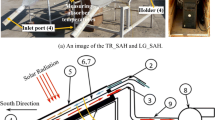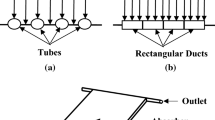Abstract
The purpose of this research is to examine how convex oval-trench dimples placed staggered on a solar air collector's absorber improved vortex heat transfer. At air mass flow rates of 0.013, 0.027, and 0.036 kg/s, convex oval-trench dimple absorbers with relative roughness heights, e/D=0.2 and e/D=0.4, as well as a flat plate absorber, were evaluated for back-pass and front-pass applications. The oval-trench dimpled absorber plates in the back-pass and front-pass achieved the maximum energy efficiency of 37.5% and 50.6%, respectively, with e/D=0.4 and 0.036 kg/s. The increase in the number of Nu in e/D=0.4 was 26% and 31% more than that of the flat plate for the examined parameter ranges of back-pass and front-pass, respectively. (e/D=0.4)/(flat plate) and (e/D=0.4)/(e/D=0.2) increased by an average of 28% and 24% in back-pass for (Nuotd /Nu0)/(fotd /f0), respectively. In front-pass, (e/D=0.4)/(flat plate) and (e/D=0.4)/(e/D=0.2) improved by 35% and 25%, respectively. The collector with a relative roughness height of 0.4 has the optimal structure for this examination of collectors with an oval-trench dimple. The results indicated that collectors with convex oval-trench dimples outperform flat plates in terms of surface area expansion and turbulence generation, which boosts thermal efficiency substantially. In addition, when the experiment results were compared, the front-pass implementation outperformed the back-pass approach. As a result, thermal systems may benefit from utilizing the convex oval-trench dimple.
Graphical Abstract


















Similar content being viewed by others
Data availability
The data that support the findings of this study are available from the corresponding author, [S.Ş.], upon reasonable request.
Abbreviations
- A c :
-
collector surface area, m2
- A p :
-
absorber plate surface area, m2
- c p :
-
specific heat capacity of air, kJ/kg °C
- D:
-
dimple print diameter
- D h :
-
hydraulic diameter, m
- Ex :
-
exergy, J
- Ex dest :
-
rate of irreversibility, J
- \(f\) :
-
friction factor
- f otd :
-
average friction factor for oval-trench dimpled SAC
- f 0 :
-
average friction factor for flat plate SAC
- f otd /f 0 :
-
friction factor increment ratio
- \(\hslash\) :
-
specific enthalpy, J/kg
- \(h\) :
-
heat transfer coefficient, W/m2 °C
- I :
-
solar irradiance, W/m2
- \(\dot{m}\) :
-
mass flow rate of air, kg/s
- Nu :
-
Nusselt number
- Nuotd :
-
Nusselt number for dimpled SAC
- Nu0 :
-
Nusselt number for flat plate SAC
- Nuotd /Nu0 :
-
heat transfer enhancement
- Nuotd /Nu0 /(fotd f0 ):
-
thermo-hydraulic performance factor
- \(\Delta p\) :
-
pressure drop, Pa
- Qu :
-
useful heat rate, W
- Q s :
-
incident energy in the collector area, W
- R :
-
function uncertainty
- Re :
-
Reynolds number
- \({\dot{S}}_{gen}\) :
-
entropy generation rate, kW/Ksspecific entropy, kJ/kg K
- s :
-
specific entropy, kJ/kg K
- T:
-
temperature, °C
- \({T}_{p}\) :
-
temperature of the absorber plate, °C
- v :
-
velocity of air, m/s
- \(\dot{V}\) :
-
volumetric flow rate of air, m3/s
- x :
-
independent variables
- W R :
-
total uncertainty
- w1,w2,wn:
-
uncertainties in the independent variables
- δ/D:
-
Relative roughness height (δ/D)
- η:
-
efficiency, %
- ρ :
-
density of air, kg/m3
- µ :
-
dynamic viscosity of air, Pa s
- ατ:
-
absorptance-transmittance
- δ:
-
dimple depth
- a :
-
air
- aa :
-
ambient air
- avg :
-
average
- c :
-
collector
- ex :
-
exergy
- i :
-
inlet
- o:
-
outlet
- p:
-
plate
- s:
-
sky
- 0:
-
flat plate
References
Close DJ, Yusoff MB (1978) The effects of air leaks on solar air heater behaviour. Sol Energy 20(6):459–463
Goel VK, Chandra R, Raychaudhuri BC (1987) Experimental investigations on single-absorber solar air heaters. Energy Convers Manage 27(4):343–349
Youcef-Ali S, Desmons JY (2006) Numerical and experimental study of a solar equipped with offset rectangular plate fin absorber plate. Renewable Energy 31:2063–2075
Yassien HNS, Alomar OR, Mohamed Salih MM (2020) Performance analysis of triple-pass solar air heater system: Effects of adding a net of tubes below absorber surface. Solar Energy 207:813–824
Şevik S, Abuşka M (2020) Enhancing the thermal performance of a solar air heater by using single-pass semi-flexible foil ducts. Appl Therm Eng 179
Moreau E (1878) Improvement in apparatus for the production of hot air, US201439A United States
Morse ES (1881) Warming and ventilating apartments by the sun's rays. US246626A United States
Miller KW (1945) Solar heat trap, US2680437A United States
Hummel RL (1978) Solar energy collection system. US4126270A, 1978-11-21, Earliest priority: 1976-01-23, Earliest publication
Pearson JT, Christopher DM (1984) Louvered air-heating solar collector. US4471761A, 1984-09-18, Purdue Research Foundation, Earliest priority: 1982-03-26, Earliest publication
Hollick JC (1985) Method for preheating ventilation air in a building. CA1196825A, 1985-11-19, Earliest priority: 1982-05-04, Earliest publication
Saini RP, Verma J (2008) Heat transfer and friction factor correlations for a duct having dimple shape artificial roughness for solar air heaters. Energy 33:1277–1287
Kim H-M, Moon M-A, Kim K-Y (2011) Multi-objective optimization of a cooling channel with staggered elliptic dimples. Energy 36(5):3419–3428
Kumar V (2019) Nusselt number and friction factor correlations of three sides concave dimple roughened solar air heater. Renew Energ 135:355–377
Mabrouk AB, Djemel H, Hammami M, Baccar M (2023) CFD modeling of rectangular solar air heater featuring curved flow passage in turbulent flow. Heat Mass Transf 59(1):1–20
Park J, Ligrani PM (2005) Numerical predictions of heat transfer and fluid flow characteristics for seven different dimpled surfaces in a channel. Numer Heat Transf A Appl 47(3):209–232
Jordan N, Wright LM (2013) Heat transfer enhancement in a rectangular (AR=3:1) channel with V-shaped dimple. J Turbomach 135(1)
Rao Y, Li B, Feng Y (2015) Heat transfer of turbulent flow over surfaces with spherical dimples and teardrop dimples. Exp Thermal and Fluid Sci 61:201–209
Xie Y, Qu H, Zhang D (2015) Numerical investigation of flow and heat transfer in rectangular channel with teardrop dimple/protrusion. Int J Heat Mass Transf 84:486–496
Murata A, Yano K, Hanai M, Saito H, Iwamoto K (2017) Arrangement effects of inclined teardrop-shaped dimples on film cooling performance of dimpled cutback surface at airfoil trailing edge. Int J Heat Mass Transf 107:761–770
Leontiev A, Kiselev N, Vinogradov YA, Strongin M, Zditovets A, Burtsev S (2017) Experimental investigation of heat transfer and drag on surfaces coated with dimples of different shape. Int J Therm Sci 118:152–167
Isaev SA, Schelchkov AV, Leontiev AI, Gortyshov YF, Baranov PA, Popov IA (2017) Vortex heat transfer enhancement in the narrow plane-parallel channel with the oval-trench dimple of fixed depth and spot area. Int J Heat Mass Transf 109:40–62
Xie S, Liang Z, Zhang L, Wang Y (2018) A numerical study on heat transfer enhancement and flow structure in enhanced tube with cross ellipsoidal dimples. Int J Heat Mass Transf. 125:434–444
Vladimir V, Andrij V, Oleksandr V (2020) Flow visualization around inclined oval dimple on flat plate. The XXIII th International scientific and practical conference, Theoretical and Practical Foundations of Social Process Management, 29 – 30 June, 2020, San Francisco, 111–117, USA
Isaev SA, Leontiev AI, Milman OO, Popov IA, Sudakov AG (2019) Influence of the depth of single-row oval-trench dimples inclined to laminar air flow on heat transfer enhancement in a narrow micro-channel. Int J Heat Mass Transf 134:338–358
Isaev SA, Mazo AB, Nikushchenko DV, Popov IA, Sudakov AG (2020) The Influence of the angle of ınclination of single-row oval-trench dimples in the stabilized hydrodynamic section of a narrow channel on the anomalous ıntensification of the separated turbulent flow. Tech Phys Lett 46(11):1064–1067
Özdilli Ö, Şevik S (2021) Production of a heat sink and its performance analysis with deep drawing method, MAS 14th International European Conference on Mathematics, Engineering. Nat Med Sci 1–8
Abuşka M, Şevik S (2017) Energy, exergy, economic and environmental (4E) analyses of flat-plate and V-groove solar air collectors based on aluminium and copper. Sol Energy 158:259–277
Burgess N, Ligrani P (2005) Effects of dimple depth on channel Nusselt numbers and friction factors. J Heat Transf 127:839
Maurer M (2008) Experimental and numerical investigations of convective cooling configurations for gas turbine combustors. Ph.D. Thesis, Institut für Thermodynamik der Luft- und Raumfahrt (ITLR), Universität Stuttgart, Stuttgart , Germany
Liu J, Song Y, Xie G, Sunden B (2015) Numerical modeling flow and heat transfer in dimpled cooling channels with secondary hemispherical protrusions. Energy 79:1–19
Mironov A, Isaev S, Skrypnik A, Popov I (2020) Numerical and physical simulation of heat transfer enhancement using oval dimple vortex generators—review and recommendations. Energies 13:5243
Abuşka M, Kayapunar A (2021) Experimental and numerical investigation of thermal performance in solar air heater with conical surface. Heat Mass Transf 57(11):1791–1806
Zhang Li, Xie S, Liang Z, Zhang J et al (2019) Numerical investigation of flow and heat transfer in enhanced tube with slot dimples. Heat and Mass Transf 55:3697–3709
Abuşka M (2016) Experimental investigation of the effect of flow path to thermal efficiency in solar air collector. CBU J Sci 12(3):473–478
Şevik S, Özdilli Ö, Abuşka M (2022) Experimental investigation of relative roughness height effect in solar air collector with convex dimples. Renewable Energy 194:100–116
Author information
Authors and Affiliations
Contributions
Mesut Abuşka: Writing–Reviewing and Editing, Validation, Investigation, Conceptualization, Data curation, Visualization. Seyfi Şevik: Writing–Original Draft, Reviewing and Editing, Methodology, Investigation, Formal Analysis, Conceptualization, Validation, Data curation, Supervision, Visualization Preparation, Resources. Özgür Özdilli: Writing–Reviewing, Software, Resources, Investigation, Validation, Conceptualization, Data curation.
Corresponding author
Ethics declarations
Conflict of interest statement
The authors declare that they have no known competing financial interests or personal relationships that could have appeared to influence the work reported in this paper.
Additional information
Publisher’s Note
Springer Nature remains neutral with regard to jurisdictional claims in published maps and institutional affiliations.
Highlights
• Solar air collectors with convex oval-trench dimples are evaluated in terms of energy and exergy.
• Comparative performance of back-pass and front-pass on solar air collector.
• The oval channel dimple solar air collector reached a maximum instantaneous thermal efficiency of 56.5%.
• This study proposes the use of a collector with a relative roughness height of 0.4.
Rights and permissions
Springer Nature or its licensor (e.g. a society or other partner) holds exclusive rights to this article under a publishing agreement with the author(s) or other rightsholder(s); author self-archiving of the accepted manuscript version of this article is solely governed by the terms of such publishing agreement and applicable law.
About this article
Cite this article
Abuşka, M., Şevik, S. & Özdilli, Ö. A comparative experimental performance evaluation of solar air collector having absorber plate with convex oval-trench dimple. Heat Mass Transfer 59, 1871–1894 (2023). https://doi.org/10.1007/s00231-023-03377-5
Received:
Accepted:
Published:
Issue Date:
DOI: https://doi.org/10.1007/s00231-023-03377-5




